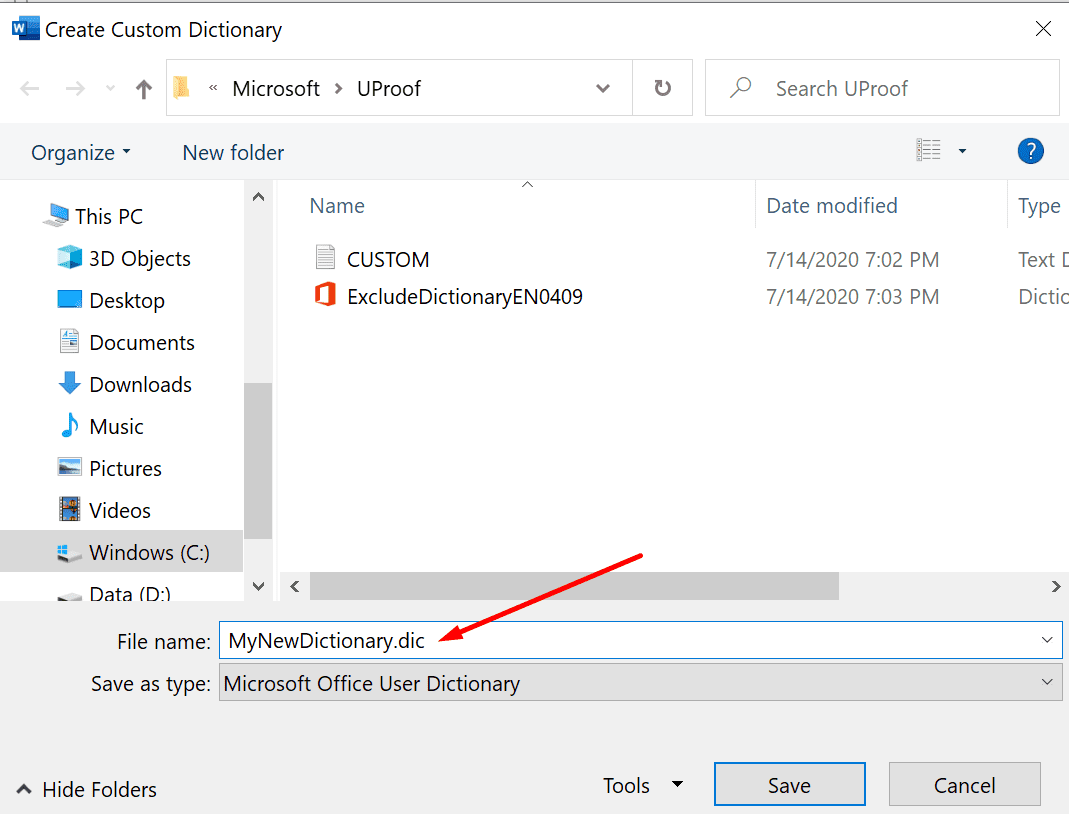

- #Custom dictionary in word 2016 how to#
- #Custom dictionary in word 2016 windows 10#
- #Custom dictionary in word 2016 pro#
- #Custom dictionary in word 2016 software#
- #Custom dictionary in word 2016 code#
Once you’ve determined which exclusion list file to use, right-click on the file and select “Open with” from the popup menu.Ī dialog box displays asking how you want to open the file.

#Custom dictionary in word 2016 code#
In our example, “EN” is the language code and “0409” is the language LCID for United States English, so we’re going to use the “ExcludeDictionaryEN0409.lex” file. If that were the case, we would refer to the last four characters in the first part of the file name (before the extension) and match up those characters with the “Language – Country/Region” items in the list of language LCID codes to find the file you should use. We only have one English file, but there could have been more than one file with “EN” in the name. We found two files on our system as shown on the image below.

There is a list that includes language codes, but it is not as complete as the previous list. There is a complete list of language LCID codes, however that list doesn’t include the language codes. This indicates which dialect of the specified language that exclusion file covers. After the language code, there are four alphanumeric (hexadecimal) digits called a “language LCID”. The main part of the file name includes a two-character language code, such as “EN” for English and “FR” for French. How can you tell which one to use? The file name is structured to help you determine exactly that. Once you’ve found the location of your exclusion list files, you may see multiple files. So, if you search for “ExcludeDictionary*.lex”, you should find the files (that’s an asterisk after “ExcludeDictionary”). All the files will start with “ExcludeDictionary” and end with the extension “.lex”. If you’re not sure where to find your exclusion list files, you can search for the files in a File Explorer (or Windows Explorer) window. C:\Users\Lori\AppData\Roaming\Microsoft\UProofĭepending on your version of Windows, the location of your exclusion list files may be different. Replace “Lori” with your user name on your system.
#Custom dictionary in word 2016 windows 10#
Our exclusion list files are located in the following location on our Windows 10 system. These files are initially empty, waiting for you to add words to them. When you installed Word, at least one exclusion list file was created. You can edit them with any text editor like Notepad, or even Word itself (as long as you save it in a text only format). The exclusion list is a roundabout way of “removing” words from Word’s main dictionary.Įxclusion list files are standard text files. If you actually did mean to use one of those words in any specific instance, you can choose whether to ignore the word each time the spell check flags it.
#Custom dictionary in word 2016 how to#
If you have chosen to include readability statistics in your proofing options, the Readability Statistics dialog box will appear after you complete the spelling and grammar check.įor more information about using the readability statistics in Word, visit “ How to Add Passive Voice to Microsoft Word’s Grammar Check and Readability Statistics” for Word 2013 and “ How to Use the Passive Voice Tool in Microsoft Word 2016.Flagging words as misspelled doesn’t mean they will be automatically corrected. Select the Resume button when you are ready to restart the check.
#Custom dictionary in word 2016 pro#
Pro Tip: The spelling and grammar check will automatically pause itself if you edit the text during the check. If you want to learn about the grammar error and see examples, open the drop-down menu above the text box. Or, select (a) Ignore Once to ignore that instance of the grammar error, (b) Don’t check for this issue to stop checking for that type of grammar error, or (c) Options for “Clarity and Conciseness” to open the Grammar Settings dialog box where you can customize the grammar check. Grammar ErrorsĬhoose an option from the suggestions list to change that instance of the grammar error.
#Custom dictionary in word 2016 software#
Occasionally, Word will be unable to provide any suggestions however, when that lapse occurs, the software will still offer the opportunity to add the word to your custom dictionary, ignore the word once, or ignore every instance of the word.


 0 kommentar(er)
0 kommentar(er)
